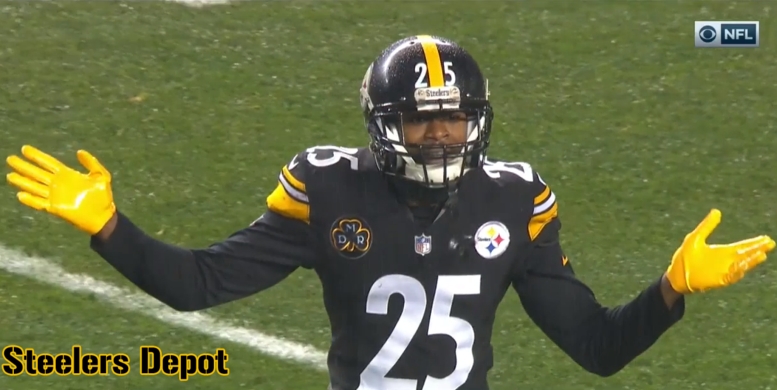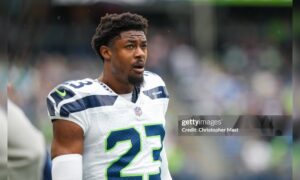It’s said a draft class can’t be fully graded until at least three years after the picks are made. That’s why after submitting grades for every Pittsburgh Steelers pick made in 2021, I began going back through and grading previous Steeler draft classes, beginning with 2018. Today begins the third class in that exercise, and starting off the Steelers’ 2016 NFL Draft is first round pick Artie Burns, a cornerback out of Miami (FL).
This exercise follows the six viewpoints (listed below) for examining and re-grading a pick. Each of the first five viewpoints gets examined and assigned a letter grade, before taking that analysis and combining it into a final letter grade. Those five viewpoints comprise much of what goes into the draft grades consumed by so many every year after the draft.
Steelers’ Career: What did the player contribute to the team that drafted him?
NFL Career: Did the player make the pick look better in hindsight after leaving Pittsburgh?
Pick Value: Did the player outperform his draft slot? Did he fail to live up to the pick used on him?
Positional Value: Was the player the best player remaining at his specific position in the draft?
Other Options: Did any players go during the next round that were better selections?
Overall Grade: A final mark to denote whether the selection was an overall positive one, or one better spent elsewhere.
Each factor in a retrospective doesn’t apply evenly to every pick made; consider the grades weighted. For example, to return a high grade in pick value, a first-round pick should have a long and impactful career, while a later-round pick needs only a couple seasons as a back-up or modest contributor to be worth the selection used on him.
Some factors are universal, though. Whether picked first overall or 259th, there will always be other options on the board to compare the player to, and steals and reaches can come from any place in the draft.
Round 1, Pick 25: Artie Burns, CB, Miami (FL)
STEELERS CAREER: C-
The selection of Burns was one that stood out as a reach when made in 2016’s first round. Burns offered plenty of speed and the desired length for the position, and thrived in man coverage for Miami. But he was much more “raw project” than “NFL-ready corner,” and had a lot of problem areas to improve on, some specifically based in the type of zone coverage Pittsburgh primarily played. Even with those concerns, it’s easy to forget that Artie Burns started off looking like a successful pick.
In his debut season across 16 games and nine starts, Burns picked off three passes, defensed 13, and made 65 tackles. He followed that up with another interception and 13 passes defensed, two fumble recoveries, and 54 tackles as a full-time starter in 2017. He allowed completions on barely over half the passes thrown his way. Those numbers did come with 18 penalties across the two seasons, but it was a very promising start to his career. Burns showed the tools to be a strong starter for the Steelers on the outside, and had analysts looking more wrong than right through two years.
And then Burns cratered, first out of a starting job in 2018 and then out of a job in Pittsburgh entirely after the 2019 season. All the promise he showed his first two seasons was replaced with blown coverages, an inability to play the position, and a visible loss of confidence. Pittsburgh demoted him from the lineup after a few games in 2018, which ended with him playing just over 300 snaps, committing five penalties, allowing completions on over 70 percent of the throws his way, defensing one pass, and making 22 tackles.
Pittsburgh declined his fifth-year option prior to the 2019 season, and Burns made only one start that final year. He played twice as many special teams snaps as he did on defense across 10 games, and Pittsburgh did not attempt to bring him back following the season.
NFL CAREER: D+
Burns latched on with the Chicago Bears as a free agent following the 2019 season. He had a chance to compete for a starting spot in the team’s secondary, and was one of the leading contenders for it before an ACL tear shelved him for the entire 2020 season. He showed enough during that training camp run to stick around and re-sign with Chicago this offseason. It’s a promising start to his post-Steeler career, and his play earned a better grade here, but that injury sabotaged it.
PICK VALUE: D+
As a mid-round pick, Burns’ couple seasons of promise to begin his career would be much more favorable toward his grade here. As a first-rounder, they are the start of what had to be a longer career to warrant that high a selection. Burns began on the right track to reach first-round value, but his sudden drop-off prevented him from reaching that type of status. He has his likely final chance now with the Bears to boost his career value. For now, two promising seasons save him from a failing grade here, nothing more.
POSITIONAL VALUE: F
The remaining cornerback selections in the 2016 draft start with a haymaker and land a few more punches before concluding. The next cornerback taken after Burns, 13 picks later by Miami, was Xavien Howard. Howard developed into one of the best few cornerbacks in the NFL, and has the fourth-biggest contract in the league at the position. He has twice led the league in interceptions, including 10 of them in 2020.
Thirty-seven selections after Burns, James Bradberry went to Carolina. He isn’t quite to Howard’s status, but Bradberry has started all 75 games he’s played in five seasons, and earned the eighth-biggest contract for a corner in the NFL from the New York Giants. Down in the third round, Kendall Fuller retains plenty of promise entering his sixth season, and third as a full-time starter. Second-round pick Mackensie Alexander was a key backup in Minnesota, and got his first chance to start last year in Cincinnati. Way down in the sixth round, Anthony Brown has started eight or more games four of his five seasons in Dallas.
Of the next four corners taken after Burns (who stuck at the position), one became elite, one is close to it, and a third is now a starter. With another two starters taken lower adding to it, this was an outstanding cornerback class that went after 25th overall.
OTHER OPTIONS: F
It doesn’t get any better when you move from looking at the rest of the cornerbacks taken to the next 32 players selected after Burns. Doubling up is Howard, but he isn’t the only elite player who went in the next round.
Picked 45th overall was Derrick Henry, who in the time since has risen from a split backfield to the best running back in football. Henry has led the league in rushing yardage and touchdowns along with carries each of the last two seasons, and just became the eighth-ever NFL back to post a 2,000-yard season. And two picks after Henry was Michael Thomas to the New Orleans Saints. Thomas has led the NFL in receptions twice, yardage once, and set a new NFL record with 149 catches in a single season.
Jaylon Smith (34th, Dallas) and Myles Jack (36th, Jacksonville) earned big-money extensions at linebacker. A pick below Jack, Chris Jones kicked from end to defensive tackle and is one of the best in the NFL for Kansas City. Cody Whitehair (56th, Chicago) is a career starter in the Bears’ O-Line, Nick Martin (50th, Houston) is the same for Houston, and Germain Ifedi (31st, Seattle) has done the same for both the Seahawks and Bears.
Hunter Henry (35th) spent several seasons with the Chargers before cashing in this offseason with New England, and Sterling Shepard has started five seasons at receiver for the Giants. Picking Burns over Howard, Henry, and Thomas is already an all-timer of a whiff. The rest of the names just add to it.
OVERALL GRADE: D
Artie Burns is what happens when a team is so laser-focused on addressing a specific major need in the first round of the NFL Draft, they force a pick at that spot even if nobody worth the selection remains on the board. The Steelers were rightfully all-in on addressing the secondary in 2016, but when Cincinnati sniped William Jackson III one pick before Pittsburgh could take him, the team pivoted to their next player at the position and reached on the pick.
Recency bias and some of the more notable mistakes Burns made at the end of his Steeler career cloud the fact that he made good on some of his promise early. For two seasons, Burns looked like someone who could finally be the reliable solution at cornerback the team had struggled to draft. But it all fell apart suddenly in 2018 and never recovered, and made him another corner that failed to see a second contract with the franchise. The fact that Howard, Henry, and Thomas went within the next 22 selections make this one of the all-time “What If” picks in team draft history.






